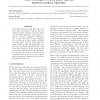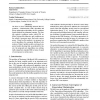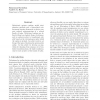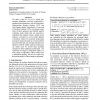88
Voted
ICML
2003
IEEE
16 years 1 months ago
2003
IEEE
In Reinforcement Learning (RL) there has been some experimental evidence that the residual gradient algorithm converges slower than the TD(0) algorithm. In this paper, we use the ...
94
Voted
ICML
2003
IEEE
16 years 1 months ago
2003
IEEE
We show a close relationship between the Expectation - Maximization (EM) algorithm and direct optimization algorithms such as gradientbased methods for parameter learning. We iden...
ICML
2003
IEEE
16 years 1 months ago
2003
IEEE
Relativized options combine model minimization methods and a hierarchical reinforcement learning framework to derive compact reduced representations of a related family of tasks. ...
82
Voted
ICML
2003
IEEE
16 years 1 months ago
2003
IEEE
We study a class of overrelaxed bound optimization algorithms, and their relationship to standard bound optimizers, such as ExpectationMaximization, Iterative Scaling, CCCP and No...
91
Voted
ICML
2003
IEEE
16 years 1 months ago
2003
IEEE
When the training instances of the target class are heavily outnumbered by non-target training instances, SVMs can be ineffective in determining the class boundary. To remedy this...
94
Voted
ICML
2003
IEEE
16 years 1 months ago
2003
IEEE
Naive Bayes is often used as a baseline in text classification because it is fast and easy to implement. Its severe assumptions make such efficiency possible but also adversely af...
ICML
2003
IEEE
16 years 1 months ago
2003
IEEE
The paper explores a very simple agent design method called Q-decomposition, wherein a complex agent is built from simpler subagents. Each subagent has its own reward function and...
ICML
2003
IEEE
16 years 1 months ago
2003
IEEE
A novel native stochastic local search algorithm for solving k-term DNF problems is presented. It is evaluated on hard k-term DNF problems that lie on the phase transition and com...
ICML
2003
IEEE
16 years 1 months ago
2003
IEEE
A new method for classification is proposed. This is based on kernel orthonormalized partial least squares (PLS) dimensionality reduction of the original data space followed by a ...
102
Voted
ICML
2003
IEEE
16 years 1 months ago
2003
IEEE
We investigate how stack filter function classes like weighted order statistics can be applied to classification problems. This leads to a new design criteria for linear classifie...






